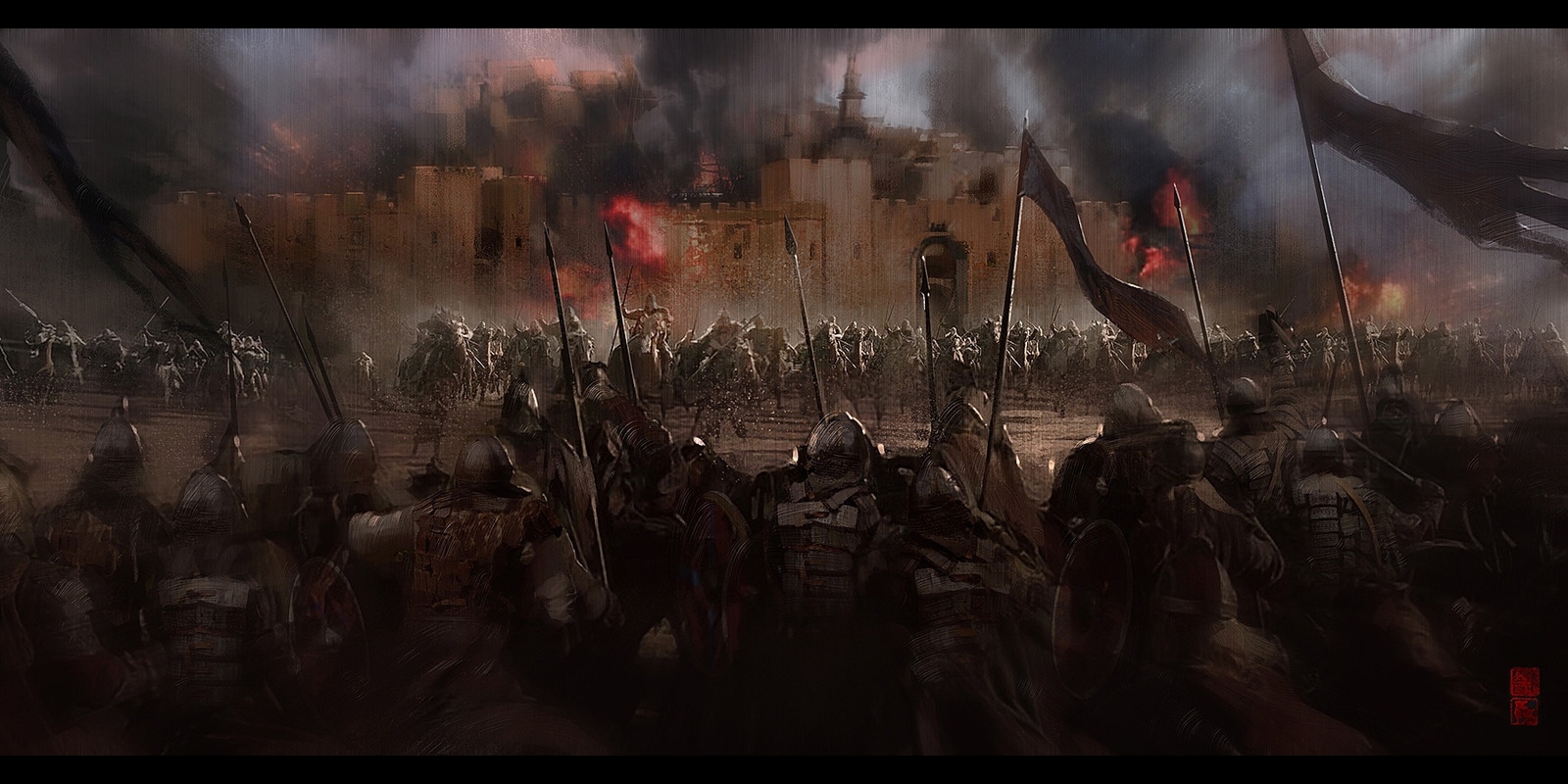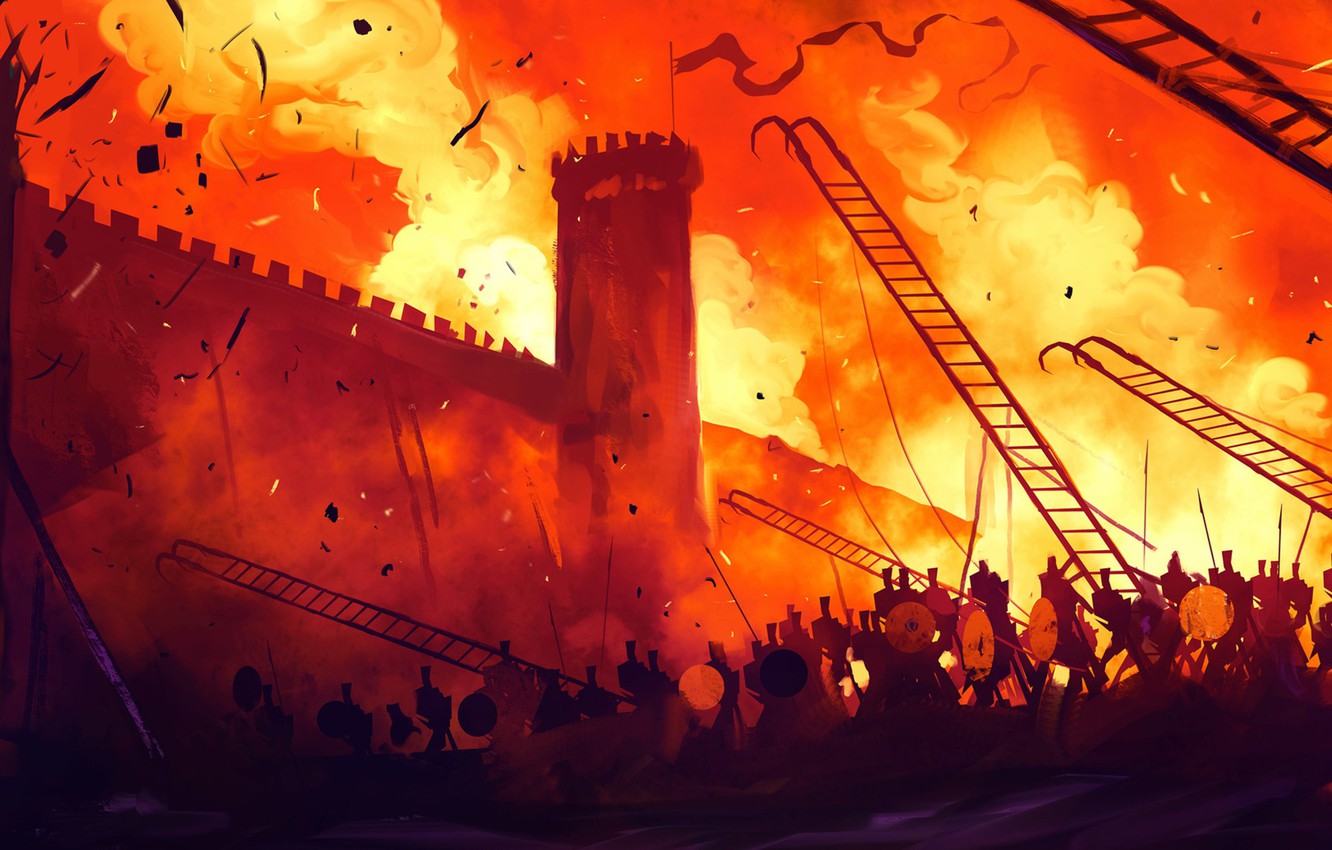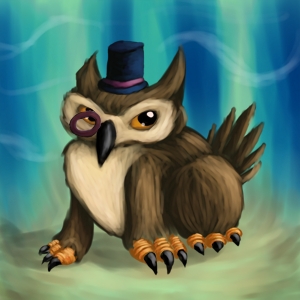Feran Invasion of Vardania
Ten thousand ships fleeing southern yoke,A new power was rising. Once weak and divided, the Feran people had been united under the banner of a new god. The Three that are One had chosen them as their people, Vodan the Prophet proclaimed, and had given unto them a new homeland. A land of fertile earth and luscious woods, where all of Ferankind would flourish until the end of days. They called it Feranar and in the winter of 841 DA, they set out to take it. A new age was dawning on the world and Vardania would never be the same after. The launch of ten thousand ships marked the begin of the Feran Migrations.
Bringing with them only fire, blood and smoke.
A single stroke to break Hrangin's peace,
Unleashed fanatical conquest that would never cease.
You Ferans, proud knights of the south so grand,
Are nothing but the scourge of Vardanian land.
Fall of the Rhovarin
Vardania on the eve of the Invasion was a land that had just emerged out of the barbaric Early Dawn Age. Its various tribes had begun to coalesce into larger polities and expand into previously empty regions. Eastern Vardania was dominated by the Rhovarin, a tribe that had first emerged in the late 5th century DA. Following the Desolation of the North in 793 DA, they rose to become the preeminent power on the continent, controlling all lands along the mighty Solryn. Then, in early 842, the Feran fleets reached Vardania.First Strike
The hammer fell on the ancient city of Siris. An important port on the southern coast, it had repeatedly come under pressure by the Rhovarin and when the Feran warlord Kenrik Hallen offered his services as a mercenary, the city's rulers gladly accepted. Once his army had entered Sirin's walls, however, it promptly attacked. The fighting lasted barely a few hours. Those not killed were driven off and Kenrik named himself Lord of the First Gate. The floodgates were open and warband after warband streamed through Siris and into Vardania.
The hammer fell on the ancient city of Siris. An important port on the southern coast, it had repeatedly come under pressure by the Rhovarin and when the Feran warlord Kenrik Hallen offered his services as a mercenary, the city's rulers gladly accepted. Once his army had entered Sirin's walls, however, it promptly attacked. The fighting lasted barely a few hours. Those not killed were driven off and Kenrik named himself Lord of the First Gate. The floodgates were open and warband after warband streamed through Siris and into Vardania.
The Prophet Lands
Only about half of the Feran population had set off by boat. Another large group, led by the Prophet himself, moved along the coast and through the lands of Interra. In late 843, they reached the mighty Amarin and crossed it in early 844. When Hrugen, King of the Rhovarin heard of this new army approaching, he marched to stop them. On a forgotten field in eastern Vardania, his army was smashed, the King and his son slain. With the Rhovarin struggling to recover, the Ferans began to assault their lands in force.
Only about half of the Feran population had set off by boat. Another large group, led by the Prophet himself, moved along the coast and through the lands of Interra. In late 843, they reached the mighty Amarin and crossed it in early 844. When Hrugen, King of the Rhovarin heard of this new army approaching, he marched to stop them. On a forgotten field in eastern Vardania, his army was smashed, the King and his son slain. With the Rhovarin struggling to recover, the Ferans began to assault their lands in force.
The Summer Coast Burns
Western Vardania was not the only place to come under attack. Beginning in late 844, thousands of ships landed along the Summer Coast. Here they met the might of the Rhomeian Empire and the walls of its ancient colonies proved too much for the Feran hosts. The outback was a different story. There was no unified nation to resist the southern attack her, only a myriad of tribes that would often fight each other as fiercely as the Ferans. The children of the Prophet had come to claim Vardania as their own and the Summer Coast ran red as they indiscriminately slaughtered anyone they would come across. Hundreds of tribes were annihilated, the knowledge and culture of centuries destroyed. Like a tidal wave of steel and fire, the Ferans washed over all lands of the south. The great Gedari and Anari, most powerful tribes of the west found themselves crushed under the tide. In the end, even the mighty rhomeian cities could not withstand the onslaught. Melan fell in 850 and Madrin in 851. Both were razed completely, only empty ruins left to look over the waters of the Great Divide.Three times against the Heartlands
By 850 DA, only the lands between the Mountains of Ash and Ice, commonly referred to as the Heartlands, remained unbeaten. The lands of the Avitae were home to seven great cities, each alone older and grander than anything the Ferans had seen before. Having grown arrogant of their recent victories, the new conquerors thought the various city-states of the Avitae easy prey. As early as 847, small warbands had begun to raid the borderlands. In the following years, three great armies would attempt to conquer the very heart of Vardania. Every one of them would fail utterly.The Mercenary
Kenrik, known by many as the Mercenary for his conquest of Siris, was the first. Through conquest and subjugation, he had become the greatest warlord in eastern Vardania and had set his sight on the great city of Moira. Attacking in early 850, he found his army torn to pieces by guerrilla attacks and ultimately annihilated under the cities walls. Kenrik was killed and his skull served as a banner for the Moiran army.
Kenrik, known by many as the Mercenary for his conquest of Siris, was the first. Through conquest and subjugation, he had become the greatest warlord in eastern Vardania and had set his sight on the great city of Moira. Attacking in early 850, he found his army torn to pieces by guerrilla attacks and ultimately annihilated under the cities walls. Kenrik was killed and his skull served as a banner for the Moiran army.
Red King
Halin Marten, the Red King, had cut a bloody swath across the west. A thousand tribes had been smashed by him or so he claimed and several times he attempted to invade the Heartlands. The final attempt, in late 851, failed not due to Avitae arms but natures wrath. He tried to surprise the Avitae by attacking from the north, over the Mountains of Ice. Trying to cross, his host was caught by a blizzard and destroyed.
Halin Marten, the Red King, had cut a bloody swath across the west. A thousand tribes had been smashed by him or so he claimed and several times he attempted to invade the Heartlands. The final attempt, in late 851, failed not due to Avitae arms but natures wrath. He tried to surprise the Avitae by attacking from the north, over the Mountains of Ice. Trying to cross, his host was caught by a blizzard and destroyed.
Emmerik the Great
At the head of a coalition of over fifty warlords, Emmerik the Great, invaded in 852. One hundred thousand soldiers stormed toward Tarquinnia, oldest and most powerful of the Avitae cities. But his army bled itself white on walls over fifty meters high and some say that his soldiers could soon climb them on the corpses of their comrades. After three months of bloodshed and under threat of nearing Avitae armies, Emmerik retreated.
At the head of a coalition of over fifty warlords, Emmerik the Great, invaded in 852. One hundred thousand soldiers stormed toward Tarquinnia, oldest and most powerful of the Avitae cities. But his army bled itself white on walls over fifty meters high and some say that his soldiers could soon climb them on the corpses of their comrades. After three months of bloodshed and under threat of nearing Avitae armies, Emmerik retreated.
Ferans have been described in a myriad of ways over centuries. Depending on the writer and their views they may be written of in the most charming of words or made out to be child devouring abominations. Every account contains the truth, at least part of it. Ferans are but human after all.
Included under Conflict
Conflict Type
War
Start Date
842 DA
Ending Date
853 DA
Conflict Result
Destruction of most Vardanian nations. Establishment of the High Kingdom of Feranar.
Myrd the Witch. Doomsinger of the Rhovarin. A nice tale told to portrait the fall of the Rhovarin as an act of divine punishment. In reality, the Rhovarin fell to our superior arms, their realm crushed under our knights hooves.The Maps Lie Maps of this ancient era show the Kingdom of the Rhovarin and other states as vast, sprawling realms. One might wonder how a rather small group such as the Ferans could have posed a threat. The maps do not represent the situation of the time accurately, however. While vast, these nations were sparsely populated. Vardanias population had only slowly recovered in the centuries following the Time of Twilight. Even the great city of Tarquinnia is stated to have less than 100.000 residents. Accounts such as that of Emmerik the Great, stating Hrugen to have fielded more than 300.000 soldiers against the Ferans are therefore seen as highly exaggerated. Knights and Knighthood Aside from cavalry and a new religion, the Feran Invasion brought with it a new concept, Knighthood. Feran Knighthood as an intermediate stage between commoners and nobleman had existed for several decades by that point. Under the influence of the Vodarian Church, as well as the Invasion, it began to change into its, now iconic, form. Concepts usually associated with knightly conduct (honour, loyalty, protection of the weak) and the Knight as the backbone of Feran armies first emerged in the immediate aftermath of the conquest.
Remove these ads. Join the Worldbuilders Guild











I was listening to that song with the lyrics "war, what is it good for?" as I read this.